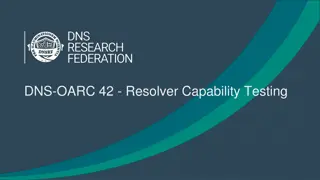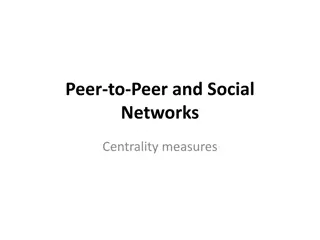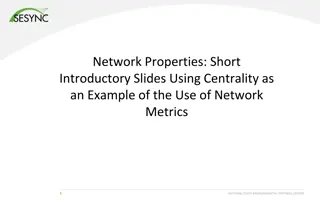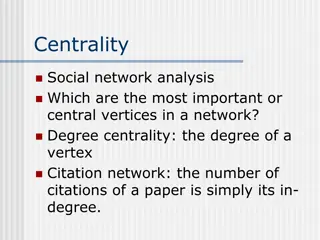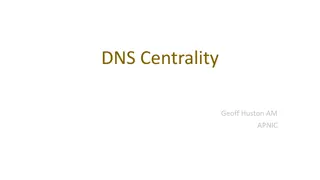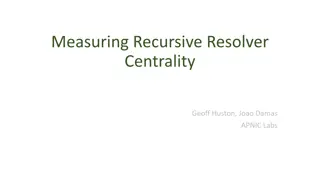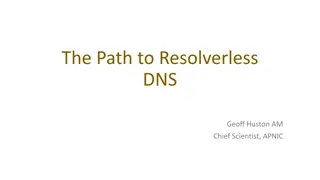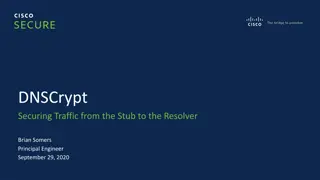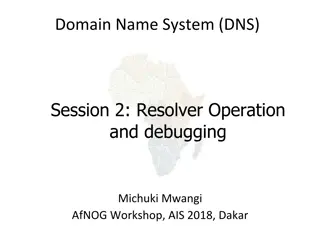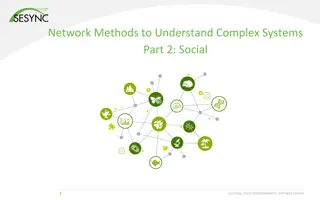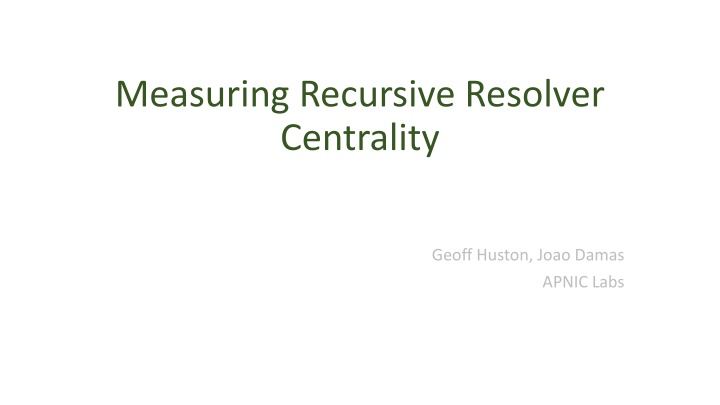
Recursive Resolver Centrality in DNS Ecosystem
Explore the significance of measuring recursive resolver centrality in the DNS, uncovering potential issues in consolidation and its impact on the internet infrastructure. Delve into the economic aspects, market dynamics, and implications for consumers in the evolving DNS landscape.
Download Presentation

Please find below an Image/Link to download the presentation.
The content on the website is provided AS IS for your information and personal use only. It may not be sold, licensed, or shared on other websites without obtaining consent from the author. If you encounter any issues during the download, it is possible that the publisher has removed the file from their server.
You are allowed to download the files provided on this website for personal or commercial use, subject to the condition that they are used lawfully. All files are the property of their respective owners.
The content on the website is provided AS IS for your information and personal use only. It may not be sold, licensed, or shared on other websites without obtaining consent from the author.
E N D
Presentation Transcript
Measuring Recursive Resolver Centrality Geoff Huston, Joao Damas APNIC Labs
Why pick on the DNS? The DNS is used by everyone and everything Because pretty much everything you do on the net starts with a call to the DNS If a single entity controlled the DNS then to all practical purposes they would control not just the DNS, but the entire Internet!
This Presentation What s the problem with centrality anyway? What does centrality in the DNS mean? How to measure DNS centrality What we measure What are we see 3
Centrality Many aspects of the Internet s infrastructure are operated by fewer and fewer entities over time 4
Whats the problem? Economics A01 (or Adam Smith s Invisible Hand) Competition rewards efficient producers Innovation that increases production efficiency is rewarded Consumers benefit from increased production efficiency and innovation Consolidation in the market Distorts the functions of an open competitive market Decreases competition pressure Creates barriers to entry in the market Reduces pressure for increased production efficiency and innovation Consumers end up paying a premium 5
Consolidation in the DNS It s not a new topic: For many years Bind was a defacto monopoly provider for DNS software. At the time every DNS recursive resolver and authoritative server ran Bind software. This has broadened out to a number of software platforms and is less of a concern today Where else might we find consolidation in today s DNS? Name Registration services Name Hosting service providers Name Resolution providers 6
Focus! Here we are going to concentrate on just one of these areas! We will look at the recursive resolver market and try to understand the extent to which we are seeing consolidation of the recursive name resolution function 7
Recursive Resolvers This function is generally bundled with an ISP s access service for public network services Which means that there is already some level of consolidation in this space as the concentration of these DNS services follows the concentration of ISPs in the retail market Is there consolidation in the DNS recursive resolution function over and above this access market consolidation? Where might we see such consolidation? 8
The Rise of Open DNS Resolvers There are some 6M open DNS resolvers in operation today* Most of these appear to be inadvertently open due to errant CPE equipment Others are explicitly configured to offer DNS resolution services as a open service Hard to say where all this started, but an early example was the the 4.2.2.2 open resolver project offered by BBN Planet in the mid-90 s, though there were many others even then At that time many ISPs used recursive resolvers as a service and some operated these platforms as a open service as a least cost / lowest admin overhead option The use of anycast in the DNS made it possible to operate a single service with a distributed footprint Open DNS was one of the early offerings of a dedicated recursive resolution service with a scaled up infrastructure Google Public DNS entered the picture with a service that took scaling to the next level 9 * https://scan.shadowserver.org/dns/
Whats the Centrality Question here? One way to measure centrality is by market share So the question here would be: What proportion of users of the Internet use <X> as their DNS resolver? We won t distinguish between end users explicitly adding their own DNS configuration into their platform and ISPs using forwarding structures to pass all DNS queries to an open resolver. Through the lens of centrality both paths to using open DNS resolvers look the same! 10
How we Measure DNS Centrality We use Google Ads as the main element of this measurement The measurement script is an embedded block of HTML5 code in an Ad The Ad runs in campaigns that generate some 10M impressions per day We get to see the DNS in operation from the inside of most mid-to-large ISPs and service providers across the entire Internet Ads provide very little functionality in the embedded scripts it s basically limited to fetching URLs But that s enough here, as a URL fetch involves the resolution of a domain name So we use unique DNS names in every ad, so the DNS queries will be passed though to our authoritative servers 11
Recursive Resolver Behaviours The task is to match the source of a query of a domain name to both a resolver and an end user We need to map query IP source addresses to resolvers understand how the DNS manages queries how the resolver lists in /etc/resolv.conf are used 12
Mapping Resolver Addresses We use periodic sweeps with RIPE Atlas to reveal the engine addresses used by popular Open DNS resolvers, and load this into an identification database 13
Understanding Resolver Behaviour Resolver Engine Service Address Resolver Engine Query Distributor Resolver Engine From Client Resolver Engine Engine Address To Server 14
Resolution Metrics Average query count per unique name: 3.4 Max observed query count in 30 seconds is 1,761 queries! (Dual stack hosts may be a factor here) Queries per Name 35% 30% 25% 20% % of names 15% 10% 5% 0% Number of queries 1 2 3 4 5 6 7 8 9 10 15
Resolution Metrics Average number of resolvers (IP addresses) per unique name: 2.1 30 second maximum resolvers seen: 94 Resolvers (IP addrs) per Name 60% 50% 40% % of names 30% 20% 10% 0% 16 Number of resolvers 1 2 3 4 5 6 7 8 9 10
First Resolver vs Full Resolver Set What happens if the authoritative server always reports SERVFAIL to all queries? We use a server that always returns a SERVFAIL error code to prompt the client to run through its full set of recursive resolvers 17
SERVFAIL Resolution Metrics Average query count per unique name: 36.5 Max observed query count in 30 seconds is 292,942 queries! Queries per Name 5% 5% 4% 4% 3% % of names 3% 2% 2% 1% 1% 18 0% 9 10 11 12 13 14 15 16 17 18 19 20 21 22 23 24 25 26 27 28 29 30 31 32 33 34 35 36 37 38 39 40 41 42 43 44 45 46 47 48 49 50 51 52 53 54 55 56 57 58 59 60 Number of queries 1 2 3 4 5 6 7 8
SERVFAIL Resolution Metrics Average number of resolvers (IP addresses) per unique name: 8.9 30 second maximum resolvers seen: 1,368 Resolvers per Name 20% 18% 16% 14% 12% % of names 10% 8% 6% 4% 2% 19 0% Number of resolvers 1 2 3 4 5 6 7 8 9 10 11 12 13 14 15 16 17 18 19 20
Recursive Resolver Stats Of the 140,000 visible recursive resolvers, just 150 resolvers account for 20% of all users and 1,500 resolvers account for 50% of all users. 10,000 resolvers account for 90% of all users However we are looking here at resolver IP addresses, and that s probably misleading. Lets try and group resolver IP addresses into resolver services 20
Recursive Resolver Stats Of the 14,600 visible recursive resolvers services, just 15 resolver services serve 50% of users 250 resolver services serve 90% of users Is this what we mean by centralisation ? 21
Details Lets break this data down into: Using a known open DNS resolver Using a resolver in the same AS as the user Using a resolver in the same country as the user Others 22
First Resolver Use 70% of users use a resolver located in the same AS as the user (ISP resolver) 17% of users use a resolver located in the same CC as the user (ISP resolver?) 15% of users use the Google open resolver (8.8.8.8) 23
All Resolver Use (SERVFAIL) 70% -> 72% for same ISP 15% -> 29% for Google use (yes, the plotting software performed a colour change sorry!) 24
Google DNS Use of Google Service per CC Within each country how many users In that country use Google s resolver? 25
Google DNS Use of Google Service by User Count Looking at the total population of users using Google s service, where are they located? 26
Google DNS Google DNS use appears to be equally split between first use (15% of users) and backup resolvers (a further 14% of users) Within each economy Google DNS is heavily used in some African economies, and central and southern Asian economies The largest pool of Google DNS users are located in India (19% of Google DNS users) Significant pools Google users are also seen in the US, China, Nigeria, Brazil and Iran (each CC has some 4% - 6% of Google s DNS users) 27
Cloudflares 1.1.1.1 service Where is Cloudflare used? Cloudflare market share Cloudflare is extensively used in Turkmenistan (80%), Iran (57%), Niger (54%) Cameroon (54%) and the Congo (49%) 28
Iran A major ISP in IRAN, MCCI, distributes its queries across Google, Cloudflare, Yandex, Neustar, OpenDNS, Quad9 and others 29
Who makes the choice? Is this the ISP s resolver performing forwarding of the query to an open resolver, or the users themselves opting out of the ISP service? The numbers vary, but it is quite common to see 60% - 80% of users in an AS having their queries sent to an open resolver when open resolvers are used Google DNS at 86% Open DNS at 27% 30
Resolver Centrality? Its not a small number of open resolvers It s just 1 Google s Public DNS Its not end users reconfiguring their devices It s the ISP And where its not the ISP it s mainly enterprise customers of ISPs Is this changing? Yes, but quite slowly 31
Is this a problem? It this an emerging distortion of the market that puts excessive market control in the hands of a small set of providers? No, not so far It s more likely that the shift of DNS functions into application realms using DoH services as an application function is a far greater threat to the current model of the DNS as a common single infrastructure 32
Thanks! Report on Resolver Use: https://stats.labs.apnic.net/rvrs





